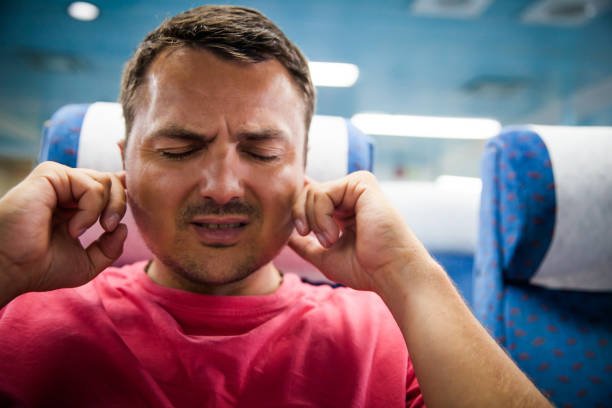Flying, Aeroplanes & Ear Health - A Guide
If you have ever wondered why your ears feel blocked or full during or after a flight, then you are not alone. In this guide we’ll investigate why flying can sometimes leave us with a feeling of fullness or blockage within the ear.
Whether you are a seasoned traveller or a first-time flyer, understanding how flying can impact your ears and how to prevent blockage can make your journey more comfortable and enjoyable.
Why and how does flying affect the ears?
In the ear there is a narrow passage called the Eustachian Tube. The Eustachian Tube is connected to the middle ear and regulates air pressure within your ear. When an aeroplane ascents and descents the air pressure changes quickly meaning the pressure in the middle ear and the air pressure of your environment are imbalanced. This prevents your eardrum from vibrating as it normally would. As the pressure changes quickly, the Eustachian Tubes often don’t react fast enough resulting in a feeling of discomfort and pain.
This is a condition known as ‘Aeroplane Ear’ which is a mild form of Ear Barotrauma. Symptoms of ‘Aeroplane Ear’ include muffled hearing, a feeling of fullness or blockage within the ear and mild temporary hearing loss. In more extreme cases of ‘Aeroplane Ear’ symptoms can include bleeding, vertigo (the sensation of the world around you spinning) and vomiting.
What’s the best way to stop my ears blocking on a plane?
There are many ways to help prevent your ears from feeling blocked on a plane, these include:
Over-the-counter nasal spray or decongestant pills - if you have any nasal congestion, allergies, or a cold use an over-the-counter nasal spray or decongestant 30 minutes – 1 hour before take-off.
Yawning and swallowing during ascent and descent – this activates the muscles that open your eustachian tubes which helps equalize the pressure in your ears.
Chewing gum or sucking hard boiled sweets – this activates the muscles that open your eustachian tubes helping to equalise pressure.
Filtered Ear plugs – using filtered ear plugs can help regulate ear pressure within your ears during the airplane’s ascent and descent. These are available from most pharmacies and work best when put in your ears an hour before take-off.
What's the best way to unblock your ears after a flight?
The best ways to unblock your ears after a flight are as follows:
Chewing, swallowing, and yawning.
The ‘Valsalva Manoeuvre’ - pinch your nose closed and shut your mouth, blow gently through your nostrils. This manoeuvre opens the eustachian tubes to equalise pressure. Avoid blowing to hard as this can damage your ears. Do not try this method if you have an ear infection, perforated eardrum or allergies causing blockage.
The ‘Toynbee Manoeuvre’ - this is like the ‘Valsalva Manoeuvre’ however, rather than using pressure in the back of your nose to equalise pressure you use the muscles in your throat to open your Eustachian Tubes. Start by pinching your nose closed, then take a sip of water and swallow. This is safe to do when suffering with an ear infection.
If you are still suffering with feelings of fullness, blockage, or mild hearing loss hours after landing, then you can also try a warm compress on the ear or steaming to help thin the mucus and earwax in your ear.
Why do my ears hurt or feel discomfort after flying?
Everybody is susceptible to ‘Aeroplane Ear’ as the pressure change from flying is happening to all passengers. However, for some people the discomfort and pain can be worse than for others. Factors that can affect ‘Aeroplane Ear’ are allergies, ear infections, cold and flu congestion, and Eustachian Tube Dysfunction (a condition which prevents your Eustachian tubes from opening properly).
Symptoms of ‘Aeroplane Ear’ should clear up on their own within a few hours of landing, if this is not the case contact a medical professional for further advice.
Can I fly with an ear infection?
Yes, you can fly with an ear infection. However, it is not typically recommended as it can exacerbate symptoms of ‘Aeroplane Ear’ causing pain and discomfort. Ear infections can affect the Eustachian tubes by causing swelling or blockage, this can make it harder for the Eustachian tubes to react to the rapid change in air pressure. Consult with your doctor before flying to make sure you are not putting your ears at risk of further damage by doing so.
Can I fly with a perforated ear drum?
It is safe to fly with a perforated ear drum, however if you have had surgery (Myringoplasty) to repair your ear drum you should not fly until a medical professional has told you that it is safe to do so. You should follow advice on how to manage potential symptoms from your doctor. Please be advised that the ‘Valsalva Manoeuvre’ is not safe to alleviate symptoms of ‘Aeroplane Ear’ for those with a perforated eardrum and should be avoided.
Are there any other ear issues to be wary of when flying?
Other issues which can affect the ears while flying or be brought on by air pressure changes are as follows:
Eustachian tube issues – If the Eustachian tubes are blocked and swollen from allergies or infection this can exacerbate ‘Aeroplane Ear’ symptoms causing pain, muffled hearing, temporary hearing loss and pain.
Middle Ear Barotrauma – changes in air pressure can cause ear pain, bleeding from the ear and dizziness.
Tinnitus – Sometimes flying can causes tinnitus (high pitched ringing noise, buzzing or whooshing sound) in one or both ears. Symptoms should subside shortly after landing.
If you experience any severe symptoms or symptoms that do not resolve shortly after landing contact a medical professional for further advice.


